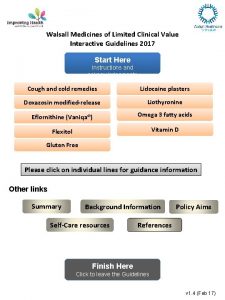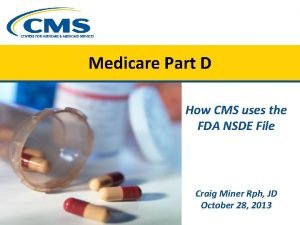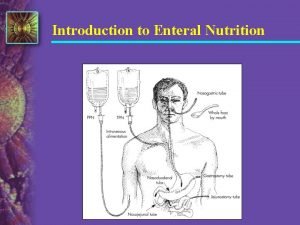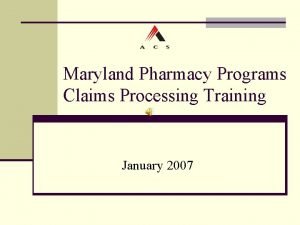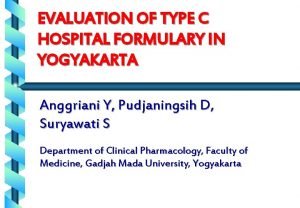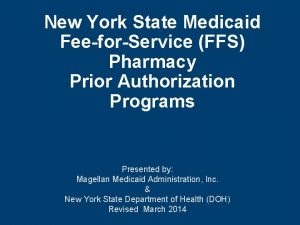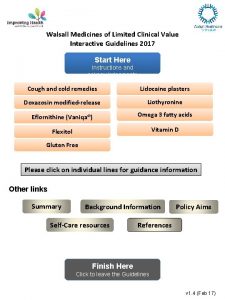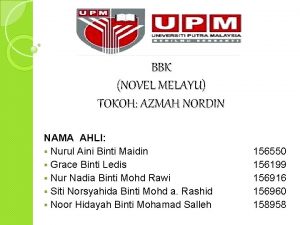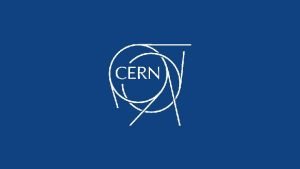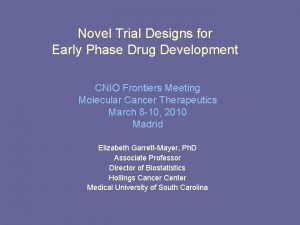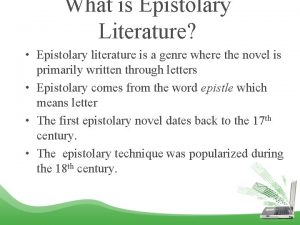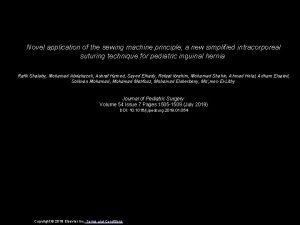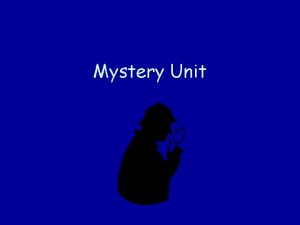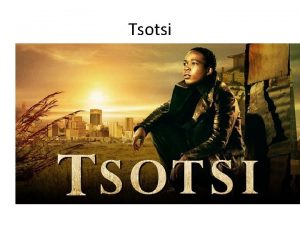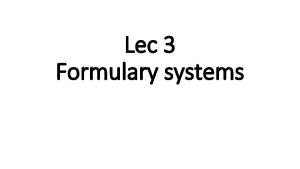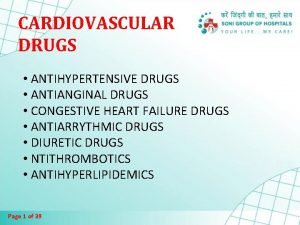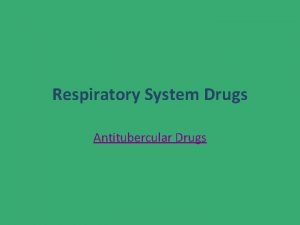Formulary Jeopardy Where Do Novel Drugs of 2016



















































- Slides: 51

Formulary Jeopardy: Where Do Novel Drugs of 2016 Fit In? Maabo Kludze, Pharm. D, MBA, CDE, BCPS, Associate Director Elizabeth A. Shlom, Pharm. D, BCPS, SVP & Director Clinical Pharmacy Program GNYHA Services, Inc. New York, NY

Program Objectives By the end of the presentation, the pharmacist or pharmacy technician participant will be able to: Ø Identify orphan drugs and first-in-class medications approved by the FDA in 2016. Ø Describe the role of new agents approved for use in oncology patients. Ø Identify and discuss the role of novel monoclonal antibodies. Ø Discuss at least two new medications that address public health concerns. Neither Dr. Kludze nor Dr. Shlom have any conflicts of interest in regards to this presentation.

2016 NDA Approvals (NMEs/BLAs) Ø Ø Ø Adlyxin (lixisenatide) Anthim (obitoxaximab) O Axumin (fluciclovive F 18) P Briviact (brivaracetam) Cinqair (reslizumab) Defitelio (defibrotide sodium) P, O Epclusa (sofosburvir and velpatasvir) P Eucrisa (crisaborole) Exondys 51 (eteplirsen) P, O Lartruvo (olaratumab) P, O NETSTPOT (gallium Ga 68 dotatate) P, O Ø Nuplazid (primavanserin) P Ø Ocaliva (obeticholic acid) P, O Ø Rubraca (rucaparib camsylate) P, O Ø Spinraza (nusinersen sodium) P, O Ø Taltz (ixekizumab) Ø Tecentriq (atezolizumab) P Ø Venclexta (venetoclax) P, O Ø Xiidra (lifitigrast) P Ø Zepatier (elbasvir and grazoprevir) P Ø Zinbyrta (daclizumab) Ø Zinplava (bezlotoxumab) P O = Orphan; P = Priority Review; Red = BLA

History of FDA Approvals

Orphan Drugs Ø FDA Office of Orphan Products Development § Orphan Drug Act (1983) – drugs and biologics ● “intended for safe and effective treatment, diagnosis or prevention of rare diseases/disorders that affect few than 200, 000 people in the U. S. or that affect more than 200, 000 persons but are not expected to recover the costs of developing and marketing a treatment drug. ” ● Incentives to pharmaceutical manufacturers: + Federal funding for clinical trials + Tax credit – 50% of clinical testing costs + 7 years market exclusivity from date of approval + FDA approval via priority status (6 vs 10 month approval; fee waived) § 7000 rare diseases affecting 25 -30 million people in U. S. www. fda. gov/For. Industry/Developing. Productsfor. Rare. Diseases. Conditions/ucm 200552 5. htm

Orphan Drugs Ø Orphan Drug Approvals § Average of 8 Orphan drugs approved per year § 349 Orphan drugs approved 1983 -2009 ● Rising rate of approvals: 33% (1983 -2005), 37% (2009 -2015), 47% (2015) ● 65% are NME vs. 35% are BLA § Drug categories ● 28% oncology ● 15% infectious diseases (including HIV) ● 11% neurological/psychiatric ● 10% enzyme deficiencies § Increasing Orphan drugs targeting biomarker-defined disease subsets (e. g. ALK+ NSCLC, BRAF V 600 E met melanoma) Kesselheim AS. Innovation and the Orphan Drug Act, 1983 -2009: Regulatory and Clinical Characteristics of Approved Orphan Drugs. Kesselheim AS, Treasure CL, Joffe S. Biomarker-defined subsets of common diseases: : Policy and economic mplications of orphan drug act coverage. PLo. S Med 2017; 14(1): e 1002190.

Hepatobiliary Diseases Defitelio® (defibrotide sodium) Epclusa® (sofosbuvir and velpatasvir) Ocaliva® (obeticholic acid) Zepatier® (elbasvir and grazoprevir)

Defitelio® (defibrotide) by Jazz Pharmaceuticals Ø Indication 1: treatment of hepatic veno-occlusive disease (VOD), also known as sinusoidal obstruction syndrome (SOS), with renal or pulmonary dysfunction after hematopoietic stem-cell transplantation (HSCT) in adults and pediatric patients Ø Veno-occlusive disease (VOD)/SOS 2 § Occurs when damaged endothelial cells are torn away from the sinusoid leading to fibrin deposition and evenutally red blood cells entering the space are blocked in very small blood vessels within the liver Ø § Incidence rate is estimated to be approximately 10– 15% and occurs within 20– 30 days of the transplant § Untreated hepatic VOD/SOS accompanied by multiorgan failure (MOF) is associated with >80% mortality Mechanism of action 2 § Promotes the breakdown of fibrin and protects endothelial cells from harmful effects of chemotherapy § Posseses anti-inflammatory, anti-ischemic, antithrombotic, and thrombolytic properties 1. Defitelio®[prescribing information]. Palo Alto, CA: Jazz Pharmaceuticals. March 2016; 2. Stein C et a. Mol Ther Nucleic Acids. 2016 Aug; 5(8): e 346.

Defitelio® (defibrotide) by Jazz Pharmaceuticals Ø Dose 1 § 6. 25 mg/kg every 6 hours § Use weight prior to the preparative regimen for HSCT to calculate dose Ø Administration 1 § Infuse over 2 hours using a 0. 2 micron in-line filter § Administer for a minimum of 21 days and until the signs and symptoms of VOD have resolved or up to a maximum of 60 days § Must be used within 4 hours if stored at room temperature or within 24 hours if stored under refrigeration Ø Safety § ADE's (incidence ≥ 10%): Hypotension, diarrhea, vomiting, nausea and epistaxis, § Serious ADRs: Hypotension 11%) and pulmonary alveolar hemorrhage (7%) Ø Ordering 2 § Verify your institution has a contract with Mc. Kesson Plasma and Biologics before ordering Ø Contraindications 1 § Antithrombotic agents 1. Defitelio®[prescribing information]. Palo Alto, CA: Jazz Pharmaceuticals. March 2016; 2. 2. https: //defitelio. com/

Defitelio® (defibrotide) by Jazz Pharmaceuticals Ø Clinical Trials Study Design Study 1 prospective study, patients had 102 a diagnosis of VOD with an associated diagnosis of multiorgan dysfunction (pulmonary, renal, or both) by Day+28 post. HSCT prospective study, diagnosis of 75 hepatic VOD and multi-organ dysfunction following HSCT Study 2 Study 3 N an expanded access program 351 for DEFITELIO for the treatment of adult and pediatric patients who developed hepatic VOD after had received a HSCT and developed hepatic VOD with renal or pulmonary dysfunction. Dose & Administration % Survived after 100 days of transplantation 6. 25 mg/kg every 6 hours for 38% Day +100 a minimum of 21 days until survival after discharge from hospital transplantation 6. 25 mg/kg infused every 6 44% Day +100 hours for a minimum of survival after treatment duration of 14 days transplantation Defitelio®[prescribing information]. Palo Alto, CA: Jazz Pharmaceuticals. March 2016 45% Day +100 survival after transplantation

Epclusa® (sofosbuvir/velpatasvir) by Gilead Sciences Ø First completely oral pan-genotypic single tablet regimen for the treatment hepatitis C virus (HCV) infection Ø Indication § Treatment of adult patients with chronic HCV genotype 1, 2, 3, 4, 5, or 6 infection Ø Potential to eliminate genotype testing Ø NS 5 B polymerase inhibitor (sofosbuvir) and NS 5 A inhibitor (velpatasvir) Ø Dose/Administration § Fixed-dose combination of sofosbuvir 400 mg/ velpatasvir 100 mg for 12 weeks § Single tablet for patients without cirrhosis or with compensated cirrhosis § In combination with ribavirin for decompensated cirrhosis Epclusa®[prescribing information]. Foster City, CA: Gilead Sciences. February 2017

Zepatier® (elbasvir/grazoprevir) by Merck Sharp & Dohme Corp. Ø Indication § Ø Ø Oral fixed-dose combination of a NS 5 A inhibitor (elbasvir) and a NS 3/4 A protease inhibitor (grazoprevir) Safety § § Ø Treatment of hepatitis C (hep C) genotypes 1 or 4 infection in adults with or without ribavirin § Genotype Patient Population Therapy Duration 1 a Treatment-naïve or Peg. IFN/RBV experienced* without baseline NS 5 A polymorphisms† Zepatier alone 12 weeks 1 a Treatment-naïve or Peg. IFN/RBVexperienced* with baseline NS 5 A polymorphisms† Zepatier plus ribavirin 16 weeks 1 b Treatment-naïve or Peg. IFN/RBV experienced* Zepatier alone 12 weeks 1 a or 1 b Peg. IFN/RBV/PIexperienced‡ Zepatier plus ribavirin 12 weeks 4 Treatment-naïve Zepatier alone 12 weeks 4 Peg. IFN/RBVexperienced* Zepatier plus ribavirin 16 weeks Zepatier alone: atigue, headache, nausea Zepatier with ribavirin: anemia and headache Dosage § § Zepatier Dosage Regimens and Durations Elbasvir 50 mg /grazoprevir 100 mg Renal impairment ● No dosage adjustments including dialysis Hepatic Impairment ● No adjustment in mild impairment ● Contraindicated in moderate or severe impairment *Peginterferon alfa (Peg. IFN) + ribavirin (RBV) †Polymorphisms at amino acid positions 28, 30, 31, or 93. ‡Peginterferon alfa + ribavirin + HCV NS 3/4 A protease inhibitor. Zepatier®[prescribing information]. Whitehouse, NJ: Merch Sh. arp & Dohme Corp. February 2017

Approval History of Direct-Acting Antiviral Agents for HCV WARNING: Risk of hepatitis B reactivation in patients coinfected with HCV and HBV Zepatier® (elbasvir/grazoprevir) Genotype: 1, 4 Approval: Jan 2016 Daklinza® (daclatasvir) Genotype: 3 Approval: Jul 2015 Sovaldi® (sofosbuvir) Genotype: 1, 2, 3, 4 Approval: Dec 2013 Viekira Pak ® Genotype: 1 Approval: Dec 2014 2013 2015 2014 Olysio® (simeprevir) Genotype 1 Approval: Nov 2014 2016 Harvoni® (ledipasvir/sofosbuvir) Genotype: 1, 4, 5, 6 Approval: Nov 2015 Eplcusa® (sofosbuvir /velpatasvir) Genotype: , 2, 3, 4, 5, or 6 Approval: June 2016

Ocaliva® (obeticholic acid) by Intercept Pharmaceuticals Ø Indication: For the treatment of primary biliary cholangitis (PBC) in combination with ursodeoxycholic acid (UDCA) in patients with poor response to UDCA for at least one year, or as monotherapy in adults unable to tolerate UDCA in adult patients Ø Primary biliary cholangitis (PBC) § Rare autoimmune destruction of the bile ducts responsible for transporting bile acids (BAs) out of the liver resulting in cholestasis Source: https: //interceptpharma. com/research-development/therapeutic-areas/primary-biliary-cirrhosis/

Ocaliva® (obeticholic acid) by Intercept Pharmaceuticals Ø Mechanism of Action § Ø Approval/Efficacy § § Ø A farnesoid X receptor agonist that reduces ALP levels Granted accelerated approval based on reduction in ALP No studies demonstrating improvement in survival or symptoms associated with PBC Dose § § Starting dosage: 5 mg orally once daily Dosage titration: increase dose to a maximum dose of 10 mg daily if there is insufficient reduction in ALP and/or total bilirubin levels after 3 months Dosage Adjustments Intolerable pruritus Hepatic impairment (moderate and severe) Ø • Add an antihistamine or bile acid binding resin • Reduce dosage to 5 mg every other day or 5 mg daily if patient is on 10 mg dose • Temporarily interrupt therapy for up to 2 weeks and reinitiate at a reduced dosage • 5 mg once weekly • Increase dosage to 5 mg twice weekly (minimum of 3 days apart) and then increase to 10 mg twice weekly (minimum of 3 days apart) based on response and tolerability Side Effects § Pruritus, fatigue, abdominal pain and discomfort, rash, oropharyngeal pain, dizziness, constipation, arthralgia, thyroid function abnormality, and eczema Ocaliva®[prescribing information]. New York, NY: Intercept Pharmaceuticals. May 2016

Dermatology Eucrisa. TM (crisaborole) Taltz® (ixekizumab) Infectious Diseases Anthim® (obiltoxaximab) Zinplava. TM (bezlotoxumab)

Eucrisa. TM (crisaborole) by Anacor Ø Indication: Atopic Dermatitis (mild/moderate) § Phosphodiesterase-4 inhibitor ● Increases intracellular cyclic adenosine monophosphate levels § Topical treatment: 2% ointment applied twice daily ● Adults and children > 2 years old Ø 4% of patients with burning or stinging at application site Ø PK: § Absorption does occur – no drug interactions documented § Rapid systemic metabolism via hydrolysis; renal excretion of metabolites Ø Studies § Two MC/R/DB/PG, vehicle-controlled trials – 1522 patients (2 -79 yrs) with 5 -95% treatable BSA Eucrisa® [prescribing information]. Palo Alto, CA: Anacor Pharmaceuticals. December 2016.

Taltz® (ixekizumab) by Eli Lilly and Co Ø Indication: Plaque Psoriasis (moderate/severe) § Interleukin-17 A antagonist § Subcutaneous injection for adults only ● 160 mg, then 80 mg at weeks 2, 4, 6, 8, 10 &12, then 80 mg every 4 weeks ● 80 mg prefilled single-dose auto-injector or syringe Ø Adverse reactions § Injection site reactions: 17% ixekizumab vs 3% with placebo § Neutropenia: 11% ixekizumab vs 3% with placebo; primarily in first 12 weeks § Serious adverse events: 2% ixekizumab vs 0. 7% with etanercept § 22% developed antibodies to ixekizumab; 2% with neutralizing antibodies Ø Pharmacokinetics § Peak serum level at 4 days § 60 -81% bioavailability § 13 days t ½ Taltz® [prescribing information]. Indianapolis, IN: Eli Lilly and Company. January 2017.

Taltz® (ixekizumab) by Eli Lilly and Co Ø Treatment of Plaque Psoriasis § Most common immune disease in U. S. @ 2 -3% of population § Treatment based on severity, cost/convenience of products, efficacy, etc. Psoriasis area and severity index (PASI) ● Static physician global assessment (s. PGA) ● § Topical treatment – with/without steroids § Phototherapy – UV light exposure § Systemic therapy for moderate/severe disease (PASI >12; s. PGA >3) Oral medications: oral retinoids, cyclosporine, methotrexate ● Injectable biologic medications: TNF-alpha blockers (certolizumab, etanercept, etc); IL 12/23 (ustekinumab); IL 17 -A (secukinumab, ixekizumab) ● Ø UNCOVER 1, 2 and 3 P/DB/MC Phase-3 Trials (3736 total patients) § Initial mean PASI scores 24 -28; s. PGA scores > 4 in 46 -52% of patients § UNCOVER-1: 34 -37% had PASI 100% improvement or s. PGA 0 scores at week 12 § UNCOVER-2 and 3: 87 -90% PASI >75% improvement; 83% with s. GPA 0/1 vs 36% with etanercept § UNCOVER-3: response maintained through week 60 Lancet. 2015; 386(9993): 541 -551; NEJM 2016; 375(4): 345 -356

Anthim® (obiltoxaximab) by Elusys Ø Orphan drug indication: Anthrax caused by B. anthracis § Antidote/antitoxin for treatment of inhalational anthrax with B. anthracis; administer with antibacterial agents Monoclonal antibody binds and neutralizes anthrax toxin ● Intended for patients with signs/symptoms of anthrax ● § Can use for prophylaxis when alternative therapies are not available or appropriate Ø Administer in monitored setting - hypersensitivity (10. 6%) and anaphylaxis (0. 9%) Ø Studies § Animal models used to demonstrate efficacy – survival improves with earlier administration and when co-administered with antibiotics § Safety and tolerability studied in adults – three trials with total of 320 adult healthy volunteers; single dose of 16 mg/kg IV over 90 minutes § Pediatric dosing based on PK extrapolation Ø To be included in National Stockpile for biowarfare/bioterrorism preparedness Anthim® [prescribing information]. Pine Brook, NJ: Elusys Therapeutics, Inc. . March 2016.

Other Agents for Anthrax Ø Raxibacumab (raxibacumab) by GSK/Human Genome Sciences § First monoclonal anti-toxin FDA approved for inhalational anthrax § 40 mg/kg IV over 2. 25 hours § Adverse events similar to obiltoxaximab Ø Anthrasil® (anthrax immune globulin intravenous) by Cangene Corp/Emergent Bio. Solutions § § Obtained from plasma of those vaccinated against anthrax Passive immunizing agent neutralizes anthrax toxin Adult dose: 420 units (7 x 50 m. L vials) administered as IV infusion Adverse reactions: headache (20%), infusion site pain (9%), nausea (9%), infusion site swelling (7%) Emerg Infect Dis. 2014 20(2): e 130687

Zinplava. TM (bezlotoxumab) by Merck Ø Indication: C. difficile infection (CDI) – to reduce recurrence § Monoclonal antibody that neutralizes C. difficile toxin B § 10 mg/kg IV infusion over 60 minutes – single dose § For adults on standard of care (So. C) antibiotics for C. difficile infection and at high risk for recurrence Of CDI ● ● ● Age > 65 years > 1 episodes of CDI prior to treatment episode CDI in the past 6 months Immunocompromised Clinically severe CDI Ø Adverse reactions § 10% have infusion-related reactions vs 8% with placebo ● Nausea (7%), pyrexia (5%), headache (4%) § Serious adverse events: 2. 3% with heart failure within 12 weeks of infusion § No patients with neutralizing antibodies in phase-3 trials Ø Half-life 19 days Zinplava® [prescribing information]. Whitehouse Station, NJ: Merck & Co, Inc. October 2016.

Zinplava. TM (bezlotoxumab) by Merck Ø Modify 1 and 2 trials - DB/R/PC Phase 3 studies in 30 countries § 2655 adults with primary or recurrent CDI on So. C antibiotics § Actoxumab (monoclonal antibody to neutralize CDI toxin A) included in Modify 1 trial § 12 week followup NEJM. 2017 376(4): 305 -317

Metabolic Disorders Adlyxin® (lixisenatide) Neuropsychiatric Diseases Briviact® (brivaracetam) Nuplazid® (pimavanserin) Ophthalmology Xiidra® (lifitigrast)

Adlyxin® (lixisenatide) by Sanofi Ø Glucagon-like peptide-1 (GLP-1) receptor agonist § Ø Indication § Ø § Once daily injection administered within one hour prior to the first meal of the day 10 mcg for first 14 days (starter pack) then increase to 20 mcg on day 15 (maintenance pack) Limitations of Use § Ø Adjunct to diet and exercise to improve glycemic control in adults with type 2 diabetes mellitus Dosage § Ø Increases glucose-dependent insulin release, reduces glucagon secretion, and slows gastric emptying Has not been studied in patients with chronic pancreatitis or a history of unexplained pancreatitis Efficacy and safety § § Approval based on FDA review of results from the Get. Goal clinical program and results from the ELIXA trial 13 clinical trials with 5, 000 adults with type 2 diabetes worldwide to evaluate the efficacy and cardiovascular safety Adlyxin®[prescribing information]. Bridgewater, NJ: Sanofi, July 2016

Xiidra® (lifitegrast 5% ophthalmic solution) by Shire Inc Ø First in class 1 § Ø Ø Ø Dry Eye Treatment Market 2 Xiidra (lifitegrast ophthalmic solution) Restasis (cyclosporine ophthalmic emulsion) lymphocyte function-associated antigen-1 (LFA-1) antagonist 1 4 1 Mechanisms of Action Indication Treatment of the signs and symptoms of Increases tear production dry eye disease § Inhibits T cell-mediated inflammation by blocking the binding of two cell surface proteins LFA-1 and intercellular adhesion molecule resulting in less inflammation Dosage One drop in each eye 12 hours apart Indication 1 One drop in each eye 12 hours apart Efficacy • All studies placebo controlled Significant increase in Schirmer wetting of 10 mm § Treatment of the signs and symptoms of dry eye disease • Improvement noted as early as 2 • 15% in Restasis group versus 5% placebo 1 weeks of therapy Dosage/Administration Effect on symptoms of dry eye disease • 6 months before improvements are observed § Instill one drop twice a day into each eye approximately 12 hours apart • Larger reduction in eye dryness score in all studies at day 42 and 84 Effect on signs of dry eye disease • Larger reduction in ICSS with Xiidra in three of the four studies at day 84 Side effects • • • Launch date 2016 2003 Price $4443 $4833 Jennifer Aniston Marissa Tomei Spokesperson Instillation site irritation Dysgeusia Decreased visual acuity • • Most common: ocular burning (17%) Other side effects (1 -5%): Eye redness, discharge, watery eyes, eye pain, foreign body sensation, itching, stinging, and blurred vision 1. Xiidra®[prescribing information]. Lexington, MA: Shire US Inc. , July 2016; 2. Source: http: //www. toyosclinic. com/eye-news/restasis-vsxiidra-3 -big-differences; 3. www. goodrx. com; 4. Restasis®[prescribing information. Irvine, CA: Allergan, June 2013

Briviact® (Brivaracetam) by UCB Inc. Clinical Trials: Proportion of patients by category of seizure Ø Indication response for all three double-blind trials § Adjunct therapy in the management of partial-onset seizures in patients 16 years of age and older with epilepsy § Analog of levetiracetam with greater affinity towards the synaptic vesicle protein 2 A in the brain Ø Dose § Initial dosage is 50 mg twice daily § Maintenance doses may be adjusted based on patient’s tolerability and therapeutic response ● Adjust down to 25 mg twice daily (50 mg per day) or up to a maximum dosage of 100 mg twice daily (200 mg per day) Ø Safety § Common side effects: drowsiness, dizziness, fatigue, nausea and vomiting § Brivaracetam is listed as a Schedule V controlled substance Ø Advantages § No need for titration at onset of treatment § Several dosage forms: tables (should not be chewed or crushed), oral solution, and injection Briviact®[prescribing information]. Smyrna, GA: UCB Inc. , March 2016

Nuplazid® (Pimavanserin) Ø Indication 1 § First drug approved to treat hallucinations and delusions associated with psychosis in Parkinson’s disease § Approval granted breakthrough therapy designation § Atypical antipsychotic that acts as an agonist and antagonist at serotonin 5 -HT 2 A receptors and to a lesser degree serotonin 5 -HT 2 C receptors Ø Parkinson’s disease psychosis 2 § § Occurs in ≥ 50% of people with Parkinson’s disease Etiology ● ● Ø Dose 1 § § Ø 34 mg per day orally (two 17 mg tablets once daily); requires no titration Not recommended in patients with severe renal impairment and hepatic impairment Safety 1 § § § Ø Natural progression of Parkinson’s disease as a result of the pathological changes within the brain Side effects associated with dopaminergic replacement therapies Common side effects included: peripheral edema and state of confusion Concentration-dependent QTc interval prolongation was observed in therapeutic range but no reports of torsade de pointes Boxed warning: increased mortality in elderly patients with dementia-related psychosis Clinical trial 1 § Pimavanserin demonstrated a statistically significantly decrease in the frequency and/or severity of hallucinations and delusions compared to placebo from baseline [-3. 06 (-4. 91, -1. 20)] 1. Nuplazid®[prescribing information]. Lexington, MA: Shire US Inc. , April 2016 2. https: //www. nuplazid. com/hallucinations-delusion/

Oncology Lartruvo. TM (olaratumab) Rubraca® (rucaparib camsylate) Tecentriq® (atezolizumab) Venclexta. TM (venetoclax)

Lartruvo. TM (olaratumab) by Eli Lilly and Co Ø Indication: Soft tissue sarcoma § Platelet-derived growth factor receptor alpha (PDGFR-a) blocking antibody § Used in combination with doxorubicin § First-line therapy for patients who have inoperable disease Ø Dose: 15 mg/kg IV infusion over 60 minutes on days 1 and 8 of 21 day cycles § Continue until disease progression or unacceptable toxicity § Premedicate with diphenhydramine and dexamethasone IV with first dose Ø Adverse reactions § Most common: nausea (73%), fatigue (69%), musculoskeletal pain (64%), mucositis (53%), alopecia (52%), vomiting (45%), diarrhea (34%), etc. § Lab abnormalities: hyperglycemia (52%), increased PTT (33%), hypokalemia (21%), hypophosphatemia (21%), hypomagnesemia (16%) § 14% incidence of Infusion-related reactions § Most common reason for permanent d/c was infusion related reactions § Dose delays most often due to neutropenia, thrombocytopenia, anemia Lartruvo® [prescribing information]. Indianapolis, IN: Eli Lilly and Company. February 2017.

Lartruvo. TM (olaratumab) by Eli Lilly and Co Phase 2 study: olaratumab + doxorubicin vs olaratumab in 133 patients with metastatic or unresectable soft-tissue sarcoma Ola + Dox (N=66) Dox (N=67) Deaths 39 52 Med. Survival, months 26. 5 (P=0. 0003) 14. 7 Med, Progressionfree survival, months 6. 6 (p=0. 0615) 4. 1 Lancet. 2016; 388(10043): 488 -497

Rubraca® (rucaparib camsylate) by Clovis Oncology Ø Indication: Ovarian cancer with BRCA mutation § PARP (poly ADP-ribose polymerase) inhibitor § Monotherapy for advanced disease previously treated with > 2 chemo agents Ø Dose: 600 mg orally twice daily § Dose reductions for adverse reactions to 300 mg twice daily § Continue until disease progression or unacceptable toxicity Ø Adverse reactions § Most common: nausea (77%), fatigue (77%), vomiting (46%), anemia (44%), constipation (40%), dysgeusia (39%), diarrhea (34%), etc. § Lab abnormalities: increased creatinine (92%), increased ALT and AST (73%), anemia (67%), lymphopenia (45%), thrombocytopenia (39%) neutropenia (35%) § 0. 5% incidence of Myelodysplastic sydrome/Acute Myeloid Leukemia § Median duration of treatment 5. 5 months; 10% of d/c due to ADEs (fatigue/asthenia) Rubraca® [prescribing information]. Boulder, CO: Clovis Oncology. December 2016.

Rubraca® (rucaparib camsylate) by Clovis Oncology Ø Accelerated approval based on MC, single-arm, open-label trial Investigator assessed N=106 Objective Response Rate (95% CI) 54% (44, 64) Complete Response 9% Partial Response 45% Median Duration of Response (95% CI) 9. 2 (6. 6, 11. 6) months Ø Other PARP inhibitors § Olaparib (Lynparza®) approved 12/19/14 for treatment of BRCA+ advanced ovarian cancer § Niraparib (Jejula®) approved 3/28/17 for maintenance treatment of ovarian, fallopian tube, or primary peritoneal cancer § Talazoparib approval expected in 2017 § Veliparib approval expected in 2018 http: //oncpracticemanagement. com/issue-archive/2017/january-2017 -vol-7 -no-1/plethora-oftargeted-agents-in-the-oncology-pipeline/

Tecentriq® (atezolizumab) by Genentech Ø Programmed death-ligand 1 (PD-L 1) blocking monoclonal antibody Ø Indications: 2 nd line agent after disease progression (salvage therapy) with platinum containing chemotherapy regimens § Advanced/metastatic urothelial carcinoma § Metastatic non-small cell lung cancer (NSCLC): also failed EGFR or ALK directed therapies if patient has these mutations Ø Dose: 1200 mg by IV infusion over 60 minutes every 3 weeks § Continue until disease progression or unacceptable toxicity Ø Adverse reactions § Most common: fatigue, decreased appetite, nausea, constipation, pyrexia § Infusion reactions in <2% of patients § Grades 3 -4 lymphopenia (10%), hyponatremia (10%), anemia (8%), hyperglycemia (5%) Ø Monitor patient for severe immune-related adverse reactions § Pneumonitis, hepatitis, colitis, endocrinopathies, myasthenia gravis, pancreatitis, infections, etc. Tecentriq® [prescribing information]. South San Francisco, CA: Genentech, Inc. October 2016.

Tecentriq® (atezolizumab) by Genentech Ø Urothelial carcinoma – locally advanced or metas. Mtatic Ø Open-label trial with tumor response assessed every 9 weeks for 54 weeks, then every 12 weeks Ø Objective response rate (ORR) of 14. 8% (95% CI 11. 1, 19. 3) Ø Median survival follow-up of 11. 7 months Ø Median progression-free survival 2. 1 months Ø Median overall survival 7. 9 months Ø Metastatic NSCLC Ø Multicenter, international, randomized, open-label trial of atezolizumab vs docetaxel with tumor assessment every 6 weeks for the first 36 weeks, then every 9 weeks Ø Study 2: Ø Median overall survival: 13. 8 months vs 9. 6 months with docetaxel Ø Deaths: 64% vs 70% with docetaxel; hazard ratio 0. 74 (P=0. 0004) Ø Study 3: Ø Median overall survival: 12. 6 months vs 9. 7 months with docetaxel Ø Median duration of response: 18. 6 months vs 7. 2 months with docetaxel Lancet. 2016 387(10031): 1909 -1920

Venclexta. TM (venetoclax) by Genentech Ø BCL-2 inhibitor – first in class, breakthrough drug Ø BCL-2 is a pro-survival protein; venetoclax restores cell’s apoptotic ability Ø Indication: Chronic lymphocytic leukemia with 17 p deletion § 2 nd line agent for this orphan indication § 3 -10% of CLL patients with 17 p deletion at diagnosis § 30 -50% of CLL relapsed or refractory patients have 17 p deletion Ø Dose: § Initial regimen: 20 mg once daily for 7 days § Increase over 5 weeks to 400 mg daily § Modify dose for Grade 3 or 4 ADEs, CYP 3 A or P-gp inhibitors; contraindicated with strong CYP 3 A inhibitors at initiation or during ramp-up Ø Adverse reactions § Most common (>20%): neutropenia, diarrhea, nausea, anemia, upper respiratory track infection, thrombocytopenia, fatigue § 44% with serious ADES: pneumonia, febrile neutropenia, pyrexia, autoimmune hemolytic anemia, anemia and tumor Venclexta® [prescribing information]. South San Francisco, CA: Genentech, Inc. April 2016.

Venclexta. TM (venetoclax) by Genentech Ø Tumor Lysis Syndrome (TLS) § § Metabolic complications resulting from rapid tumor reduction Risk factors: high tumor burden, renal impairment (<80 m. L/min) Occurs 6 -8 hrs after first dose and increased doses Sxs: nausea, vomiting, diarrhea, weakness, fatigue, electrolyte disturbances (increased potassium, phosphate, uric acid; decreased calcium) § Reduce incidence: ● Administer prophylactic hydration and anti-hyperuricemic agents ● Weekly dosing ramp-up to reduce the incidence of TLS Ø Efficacy based on open-label, single-arm, multicenter trial (N=106) § § § Patient received median of 2. 5 prior therapies Objective response rate 80% (95% CI 71. 3, 87. 3) Complete remission 6% Partial remission 70% Duration of response ranged 2. 9 to 19+ months

Neuromuscular Disorders Exondys 51 TM (eteplirsen) Spinraza. TM (nusinersen sodium) Zinbryta® (daclizumab)

Exondys 51™ (eteplirsen) by Sarepta Therapeutics, Inc. Ø Duchenne Muscular Dystrophy § § Recessive X-linked genetic disorder that effects predominatnly males a very young age Characterized by extreme muscle fatigue and rapid muscle degeneration due to lack of dystrophin in the body Dystrophin is the necessary protein that keeps the muscles in the body intact. Symptoms generally present during preschool years and become progressively severe ● As patients reach adulthood the disease has already affected heart and respiratory muscles

Exondys 51™ (eteplirsen) by Sarepta Therapeutics, Inc. Ø First and only treatment for Duchenne muscular dystrophy (DMD) § Approved under accelerated approval and heavily contested ● FDA stated “A clinical benefit of Exondys 51, including improved motor function, has not been established” ● Continued approval for this indication may be contingent upon verification of a clinical benefit in future trials ● Significant support and public pressure (i. e. Cure. Duchenn) ● Approval based on a surrogate marker of increase in dystrophin in skeletal muscle exhibited by some patients who were treated Ø Indication § § Treatment of DMD in patients with a confirmed mutation of the DMD gene that is to exon 51 skipping Mechanism of Action ● designed to bind to exon 51 of dystrophin pre-m. RNA that causes exclusion of this exon during production of a truncated dystrophin protein Exondys 51[prescribing information]. Cambridge, MA: Sarepta Therapeutics, Inc. , September 2016

Exondys 51™ (eteplirsen) by Sarepta Therapeutics, Inc. Ø Dosing and Administration § 30 mg/kg administered once weekly as a 35 to 60 minute intravenous infusion § Application of a topical anesthetic cream to the infusion site prior to administration may be considered Ø Cost: $300, 000 per patient per year Ø Clinical trials § 48 week trials evaluating pre- and post-treatment percentage of normal dystrophen levels Study Endpoints Study Conclusion Study 1 Dystrophin production and the 6 -minute walk test (6 MWT) No significant difference in change in 6 MWD between treated and placebo patients Study 2 6 MWT No evidence of a clinical benefit Study 3 Dystrophin levels in muscle tissue Dystrophin levels increased 0. 28% from baseline (pre-treatment 0. 16% vs. post-treatment 0. 44%; p=0. 008) Exondys 51®[prescribing information]. Cambridge, MA: Sarepta Therapeutics, Inc. , September 2016

Spinraza™ (nusinersen) by Biogen Inc. Ø Indication § First marketed treatment for spinal muscular atrophy (SMA) in pediatric and adult patients Ø SMA § An autosomal recessive genetic disorder caused by a mutation in the survival motor neuron (SMN) gene 2 § Normally the SMN 1 gene produces a SMN protein in the spinal cord responsible for functioning nerves that control muscles § SMA patients produce minimal amounts of SMN protein causing improper nerve cell function and eventually muscle atrophy § Symptoms include difficulty breathing, swallowing that eventually leads to debilitating and oftentimes fatal muscle weakness Spinraza™ [package insert]. Cambridge, MA. Biogen Inc. , December 2016. Image source: https: //www. togetherinsma. com/en_us/home/introduction-to-sma/smn 1 -gene. html

Spinraza™ (nusinersen) by Biogen Inc Ø Mechanism of Action 1 § Ø Antisense oligonuceotide designed to treat SMA caused by mutations in chromosome 5 q that causes lack of SMN protein Dosing 1 § § 12 mg (5 m. L) per administration Initiate treatment with 4 loading doses ● § Ø Common ADRs included upper and lower respiratory infection and constipation. Warnings and precautions: coagulation abnormalities, low blood platelet, count and renal toxicity Clinical Studies 1 § Ø Administer as intrathecal bolus injection over 1 to 3 minutes Must be administer within 4 hours of removal from vial Safety 1 § § Ø Maintenance doses should be administered once every 4 months thereafter Administration 1 § § Ø first three loading doses should be administered at 14 -day intervals; the 4 th loading dose should be administered 30 days after the 3 rd dose 21 (40%) patients in the nusinersen-treated group (n=52) achieved improved motor milestones compared to 0 (0%) in the placebo-control group (n=30) (p<0. 0001) Cost 2 § § First year: $125, 000 per injection x 6 injections = $750, 000 $375, 000 each subsequent year for the rest of the patient’s life 1. Spinraza™ [package insert]. Cambridge, MA. Biogen Inc. , December 2016. 2. http: //www. fiercepharma. com/pharma/biogen-s-375 k-spinraza-price-puts-a-sovaldi-style-spotlight-rare-disease-meds

Zinbryta® (daclizumab) by Abb. Vie Inc. Ø Novel mechanism of action for relapsing multiple sclerosis (MS) § Ø Humanized monoclonal antibody that selectively binds to the CD 25 subunit of the interleukin-2 receptor Indication § Treatment of adult patients with relapsing forms of MS Clinical Trials § Recommended to be reserved for patients who have had a poor response to two or more drugs Daclizumab 150 mg SQ Avonex 30 mcg IM once p value for the treatment of MS due to safety profile every 4 weeks weekly Ø Dosage/Administration Annualized relapse rate 0. 216 0. 393 § 150 mg self-administered subcutaneous injection once monthly 45% (relative reduction) <0. 0001 Ø Safety: Zinbryta Risk Evaluation and Mitigation Strategy (REMS) Program Proportion of patients relapse 67% 51% <0. 0001 free § Prescriber must be certified § Patients must enroll in the program and comply with ongoing monitoring requirements MRI Results: mean number of 4. 31 9. 44 <0. 0001 § Pharmacies must be certified and must only dispense to authorized patients new or newly enlarged lesions 54% (relative reduction) Ø Warnings/Precautions/Contraindications § § § Boxed warning for liver injury including autoimmune hepatitis and other immune-related conditions Contraindicated in pre-existing liver impairment and history of autoimmune conditions of the liver Live vaccines are not recommended during therapy and up to 4 months after discontinuation Zinbryta®[prescribing information]. North Chicago, IL: Abb. Vie Inc. , May 2016

Respiratory Disorders Cinqair® (reslizumab) Radiopharmaceuticals Axumin. TM (fluciclovine F 18) NETSPOTTM (gallium Ga 68 dotatate)

Cinqair® (reslizumab) by Teva Ø Indication § Interleukin-5 (IL-5) antagonist monoclonal antibody § Add-on maintenance treatment of severe asthma in adults (>18 years) with eosinophilic phenotype § Not for acute asthma exacerbations Ø Dose § 3 mg/kg IV infusion over 20 -50 minutes every 4 weeks § Available as 100 mg/10 m. L single use vials Ø Adverse reactions § Oropharyngeal pain (2. 6%), elevated CPK (14%), myalgia (1%), musculoskeletal ADEs (2. 2%) § Severe ADEs: ● Anaphylaxis (0. 3%) within 20 minutes after infusion of dose – administration by healthcare professional ● Malignancies (0. 6%) – diverse types § Neutralizing antibodies in 4. 8% of patients over 36 months Cinqair® [prescribing information]. Frazer, PA: Teva Respiratory, LLC. May 2016.

Cinqair® (reslizumab) by Teva Ø Four Phase 3 studies included in FDA evaluation § 16 week and 52 week studies compared reslizumab 3. 0 mg/kg q 4 weeks vs placebo § Patients with serum eosinophil level of > 400/mc. L (studies 1, 2 & 3) + at least one asthma exacerbation in past 12 months requiring systemic corticosteroids § Asthma exacerbations – primary efficacy outcome of Studies 1 and 2 Statistically signif decrease in all exacerbations, exacerbations requiring systemic CS use, exacerbations resulting hospitalization and/or ED visit § Lung function – all studies and primary efficacy endpoint in Studies 3 and 4 Study FEV 1 change in m. L (95% CI) Study 1 137 (76, 198) Study 2 93 (30, 155) Study 3 160 (60, 259) Study 4 (patients not selected for eos > 400 76 (-6, 158) mc. L) Cinqair® [prescribing information]. Frazer, PA: Teva Respiratory, LLC. May 2016.

New Radiopharmaceuticals Ø Axumin. TM (fluciclovine F 18) § Indication: Used with PET imaging in men with suspected prostrate CA recurrence and elevated PSA levels after treatment (positive scans increase as PSA levels increase) § Dose: 370 MBq (10 m. Ci) as bolus IV; scan 3 -5 min after admin § ADEs: pain at injection site, erythema, dysgeusia § Fluciclovine F 18 is transported across cells by LAT-1 and ASCT 2 which are more abundant in prostate cancer cells Axumin® [prescribing information]. Oxford, UK: Blue Earth Diagnostics Ltd. May 2016.

New Radiopharmaceuticals NETSPOTTM (gallium Ga 68 dotatate) Orphan Drug Indication: Used with PET imaging to identify somatostatin receptor positive neuroendocrine tumors (NET) in adults and children Dose: 2 MBq/kg (0. 054 m. Ci/kg) up to 200 MBq (5. 4 m. Ci) by IV bolus Drug Interaction: Somatostatin analogs may interfere with Ga 69 dotatate binding Scanning with Ga 68 dotatate improves sensitivity and specificity NETSPOT® [prescribing information]. New York, NY: Advanced Accelerator Applications USA, Inc. June 2016.

Jeopardy Game

Questions?
 Silverscript formulary
Silverscript formulary Walsall ccg formulary
Walsall ccg formulary Nsde file
Nsde file Modular enteral formula
Modular enteral formula Emis read code list
Emis read code list Madap fax number
Madap fax number Types of hospital formulary
Types of hospital formulary Emedny formulary
Emedny formulary Nbpdp formulary
Nbpdp formulary Walsall ccg formulary
Walsall ccg formulary Graphic novel terms and concepts
Graphic novel terms and concepts Timulak kapal perang
Timulak kapal perang Bildungsroman definition
Bildungsroman definition Existential themes
Existential themes Extraction system novel
Extraction system novel How does nick characterize the guests at gatsby’s party?
How does nick characterize the guests at gatsby’s party? Novel clinical drug trial design
Novel clinical drug trial design Chinese box structure wuthering heights
Chinese box structure wuthering heights Midground graphic novel
Midground graphic novel Ciri penulisan kreatif
Ciri penulisan kreatif Harper lee genre
Harper lee genre David wechsler ap psychology
David wechsler ap psychology Unsur unsur resensi
Unsur unsur resensi Elements of gothic literature
Elements of gothic literature What is a splash page in a graphic novel
What is a splash page in a graphic novel Utopian novel definition
Utopian novel definition Story elements of cinderella
Story elements of cinderella Epistolary literary definition
Epistolary literary definition Realism 1850 to 1900
Realism 1850 to 1900 Dystopia utopia definition
Dystopia utopia definition One subject of felipe alfaus second novel grammar
One subject of felipe alfaus second novel grammar Finer criteria for research questions
Finer criteria for research questions Independent novel definition
Independent novel definition Victorian age themes
Victorian age themes Augustan novel
Augustan novel Blood on the river novel study
Blood on the river novel study Newer drug delivery system
Newer drug delivery system Hot sat
Hot sat How did the northerners react to the novel?
How did the northerners react to the novel? Di caprio
Di caprio Victorian novel definition
Victorian novel definition Novel data science applications
Novel data science applications What does gothic fiction mean
What does gothic fiction mean The best christmas pageant ever novel study
The best christmas pageant ever novel study Novel sunkris business solutions
Novel sunkris business solutions Psychological allegory definition
Psychological allegory definition Gothic literature definition
Gothic literature definition The sewing machine novel
The sewing machine novel Elements of gothic literature in frankenstein
Elements of gothic literature in frankenstein Elements of a mystery novel
Elements of a mystery novel Kari graphic novel
Kari graphic novel Who is the author of tsotsi
Who is the author of tsotsi

